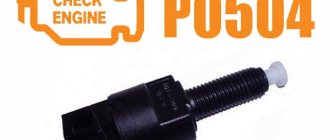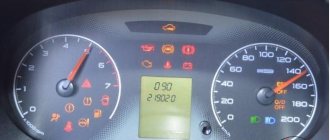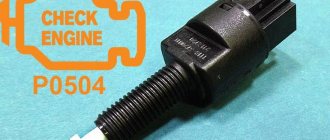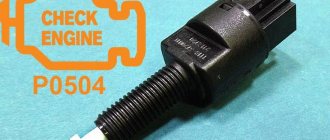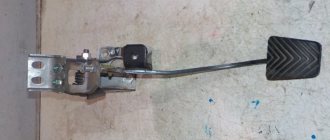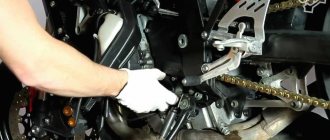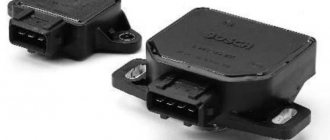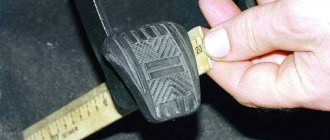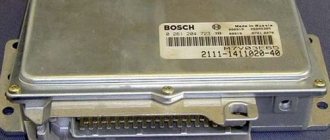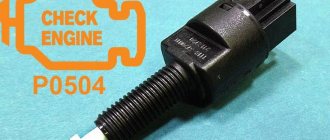The popular Priora was designed in the spirit of the times, so the computer even controls such a unit as the clutch. The electronics do not control the process of turning the clutch on and off, but the clutch sensor on the Priora, installed under the clutch pedal, collects information about the position of the pedal. This data enters the electronic engine control unit and is used to optimize engine operation depending on the driving mode, and also makes it possible to use cruise control on the car.
Replacing the Priora clutch pedal sensor, photo and video instructions
On the presented Lada Priora, the following problem occurred: when you pressed the clutch pedal while changing gears, noticeable jerks appeared, and the Check Engine light came on on the dashboard. The owner went to a service station, where diagnostics revealed a faulty clutch sensor, or rather a break in its wire. The service offered to replace it, which would involve dismantling the pedal assembly, but they did not have this sensor in stock. On the way to the store, I decided to replace it myself.
What is a clutch sensor used for?
In a car equipped with an electronic gas pedal, the clutch sensor helps the ECU make the correct decision when the car is moving; a smooth start from a place depends on its operation; it eliminates jerks when changing gears. If the sensor is faulty or its wire is broken, it begins to twitch when the speed changes. The sensations are similar to when at first speed we raise the speed to maximum, and then suddenly release the gas pedal.
Priora clutch device
The clutch briefly connects the engine and transmission when changing gears and for continuous transmission of torque when the vehicle is moving. The transmission remains intact and is subject to overloads. Clutch designs are frictional, hydraulic and electromagnetic.
The most common type is friction. It is located under the hood of the car. Magnetic polarity is used by electromagnetic, and the pressure of the working fluid is used by hydraulic. The clutch mechanism includes the following parts:
- basket;
- pressure plate assembly;
- driven disk;
- release bearing.
Each vehicle has a dry-type single-plate clutch with a central pressure spring, which is disengaged using a backlash-free cable drive with an automatic cable adjustment mechanism. The basket is a steel casing that contains a diaphragm-type pressure spring and a disk mounted on 3 pairs of plates. The basket is attached with 6 bolts to the flywheel and closed with an aluminum crater.
The upper part of the clutch pedal resembles a double-armed lever, at the end of which there is a finger. The drive cable for turning off the part is connected to it. The length of the cable is adjusted by a ratchet mechanism. The cable is in a metal sheath and has a polyethylene coating. Using a bracket, which serves as a limiter for the clutch pedal travel, its upper end is attached to the pedal assembly. A corrugated cover covers the lower end of the cable.
It is activated using a fork that rotates in two bushings. The upper one can be removed, but the lower one is tightly pressed into the clutch crater. When turning the fork, the driver exerts a force on the compression spring through the ball bearing. It is located on the clutch release clutch and is connected to the drive fork using a U-shaped spring. In a Priora car there is a sensor that will best indicate clutch malfunctions.
Replacing the clutch sensor yourself.
A new sensor was purchased, its article number is VAZ 1118-3720015, the exact name is “VAZ clutch pedal position signal switch”, the price is 260 rubles. Please note that the cord on the new sensor is much shorter, perhaps this is done so that it does not dangle and rub against the pedal. It comes with a new bracket and screws.
Since the wire of the sensor was broken, you could try to solder it or replace it as suggested at the service station by removing the pedal assembly. In the end, we will try to go our own way. We open the hood, unscrew the frill, wipers, and lift the coolant reservoir a little upward. Part of the plastic is attached with double-sided tape, so stock up on it in advance; you will need it during reassembly.
This plastic casing covers the top of the clutch pedal:
On the bottom side there are two self-tapping screws for fastening the sensor:
We unscrew them, although this will not be so easy. Then we go into the interior and remove the old sensor from it.
To make it easier for us to screw the bolt to the new bracket in constrained conditions, we first first turn the thread:
Use soft copper wires to align the center of the holes:
Now we pull out one wire and tighten the fastening screw in its place. We compress the bracket itself in the area of the pedal assembly with a piece of foam sponge so that it does not fall or move. We tighten the second fastening screw. In order to put on the spring, the following homemade device was made:
We connect the connector and assemble everything in the reverse order. After replacing the sensor, the problem disappeared, the Check on the instrument panel stopped lighting after a while.
Video of replacing the Priora clutch pedal sensor:
Backup video on how to replace the clutch sensor on a Priora:
Source
How does the electronic engine management system work?
The electronic engine control unit controls most of the vehicle's components, excluding the steering and suspension. ECU programs include presets (tables), according to which optimal operating modes are calculated. Many sensors installed on the car read information about speed, movement, engine speed, activated mechanisms and units. Based on the tables, the ECU changes the ignition mode, turns on additional functions and regulates the composition and amount of the air-fuel mixture entering the cylinders.
Functions of the Priora clutch sensor
Data about the current mode of the clutch mechanism is important for engine control. If the clutch is open, it is necessary to reduce the fuel supply and reduce engine speed. It is optimal to do this in accordance with the current speed of the vehicle, without switching to idle mode. A driver, especially an inexperienced one, may make mistakes, which leads to increased load on the engine and clutch. The on-board computer, based on the readings of the clutch sensor, adjusts the engine operating mode, setting the optimal speed. Also, the clutch sensor on the Priora, in combination with the speed sensor, allows the computer to evaluate the performance of the unit and signal problems.
Installing a clutch sensor on a Priora allowed:
- reduce fuel consumption;
- make driving easier and more enjoyable;
- control the serviceability of the coupling;
- extend clutch life.
Therefore, the serviceability of the sensor affects the service life of the units, fuel consumption and is extremely important for the correct operation of the ECU.
Operating principle of the Priora clutch sensor
What is a Priora clutch sensor? The operating principle of the device is no different from a simple limit switch. When the pedal is not pressed and the clutch is engaged, the sensor contacts are open. When you press the clutch drive, the limit switch closes, sending a signal to the computer to separate the clutch disc and basket.
The clutch sensor is installed on the pedal mounting assembly so that the tip of the pedal touches the limit switch.
The sensor design is simple and reliable, but this does not exclude the possibility of breakdowns and malfunctions in its operation.
Sachs clutch
The production of clutches for various car brands also has its own innovations. The clutch, like all other mechanisms, wears out quickly, and every driver wonders how to choose the right mechanism. Driving style and operating conditions are directly proportional to service life. Therefore, Sachs specialists, taking into account all the wishes of drivers, have released completely new, environmentally tested flywheels, release bearings, clutch discs and slave cylinders, compact clutch units and other equally interesting design solutions. These new products include:
- MZ type clutch basket with pull-out action.
- XTend with automatic wear compensation.
- Dual-mass flywheel ZMS.
- Release bearing type CSC.
- Ultra-compact clutch unit (for sports cars).
Which clutch to install is up to you, but if the driver takes good care of his car, replacement can be done after 100,000 km. The clutch pedal is a kind of indicator of the technical condition of the engine and transmission.
It signals various malfunctions and requires prevention and constant monitoring. Competent and correct replacement of the clutch, using all the capabilities of these designs will extend the life of your car.
Purpose, types
The purpose of the clutch is to briefly disconnect the engine and gearbox so that the gear ratio in the box can be changed, as well as ensuring a smooth start to movement.
There are several types used on cars:
The most widespread is the friction type. It is used together with mechanical and robotic ones. In automatic and CVT transmissions, the torque converter plays the role of clutch.
We will not touch on the clutch of automatic and CVT transmissions for now; we will focus on the friction clutch, since it is common in passenger vehicles.
Signs of a malfunction of the Priora clutch sensor
This sensor is connected to the car’s ECU; accordingly, the first sign of a breakdown is the reaction of the control unit in the form of the appearance of a corresponding signal on the dashboard. The nature of movement and operation of the car engine also changes. Symptoms of malfunction are as follows:
- The “Check Engine” light is on;
- when starting to move the car jerks;
- When you press the clutch pedal, the engine speed rises or falls sharply.
The warning lamp on the instrument panel lights up if the computer does not receive a signal from the clutch sensor within 2 seconds from the moment the vehicle starts moving or within 4 seconds when changing speed while the vehicle is moving.
The sensor has a very simple design, so there are few reasons for failure:
- faulty sensor contacts;
- break or short circuit of the wires going to the sensor;
- Incorrect installation of the sensor near the pedal.
Important: the clutch sensor is installed only on Priora models equipped with an electronic throttle. If the car is equipped with a regular throttle cable, there is no clutch sensor. Also, when replacing a sensor, you should focus on its model. Sensors from all-wheel drive VAZ and Priora sensors are not interchangeable.
What is it needed for
The clutch pedal sensor is used on Priora cars with an electronic gas pedal. The sensor serves to determine the appearance of load on the engine, thus this sensor helps when the car starts to move from a standstill, increasing engine speed at the moment the clutch is released.
Driving without this sensor or with its malfunction is possible, but this significantly affects the operation of the entire internal combustion engine as a whole, since the engine control unit will not be able to determine the load torque on the internal combustion engine.
Replacing the Priora clutch sensor
To dismantle the Priora clutch sensor, you just need to unscrew the two screws holding it to the clutch pedal. But to get to them, you need to do a lot of operations. Removing the Priora clutch sensor is done as follows:
After removing the sensor, you can replace it with a new one or repair it.
The sensor is installed like this:
- secure the sensor with self-tapping screws;
- install the rubber clutch pedal cover;
- install frill;
- secure the windshield wiper blades.
Location
The clutch sensor on a Priora car is located on the pedal assembly, you can see it by looking under the panel on the driver's side; wires go to the sensor from the green connector on the pedal assembly.
Access to replace or repair the sensor is only possible after removing the frill, since it is impossible to remove the sensor without removing the wipers and frill.
Repair of the Priora clutch sensor
Often, sensor malfunctions can be easily resolved without replacing it.
First you need to check whether the sensor end reaches the clutch pedal pusher. If the pusher does not press on the limit switch, it is necessary to adjust the position of the sensor relative to the pedal.
Another common failure is a break in the wires going to the sensor contacts. This malfunction can be easily detected by checking that the wires are securely fixed with your fingers. To fix this problem, you need a soldering iron, solder and rosin. When the sensor is removed from the car, soldering wires to its contacts is not difficult.
If the sensor wires are not broken and the limit switch reaches the pusher, the problem may be a faulty sensor contact or a broken limit switch. They may oxidize, become deformed or break. The functionality of the contacts can be checked using a multimeter. To do this, you need to connect the device to the sensor terminals and check the change in resistance between them when you press the limit switch.
Oxidized contacts can be cleaned, restoring the functionality of the sensor. If this does not work, it should be replaced. The price of this part is low, and you can buy it at most auto stores.
Replaced the clutch sensor. This sensor is located in the cabin, directly above the clutch pedal. You can say at its axis of rotation (or whatever it is called), in short, where it is attached.
This is what the clutch sensor looks like with a wire and a connector.
As far as I know and understand, this sensor is only installed on cars with E-gas, but there are no throttle position and idle speed sensors. But all this is answered by E-gas. If I'm wrong, please correct me. The first symptom is that the clutch sensor is dead - Jackie Chan came to visit me. To be honest, I didn’t even do the diagnostics. The most interesting thing is that the check light came on after about 400-500 km, when it started to become really dull. It’s interesting that the sensor started to go dull yesterday. The next day I start it, drive and everything is fine. But over time, everything is new again. Or it could all stop before I got home, and the next day it would start drizzling again in the morning. In short, nothing is clear))).
And it slows down in the following way: when changing gears (let’s say from 3 to 4), you squeeze the clutch and the rpms immediately jump by about 500 (maybe a little more). Or in another way: you are accelerating or driving at one speed and decided to switch, and then when you press the clutch the car itself picks up speed and immediately drops it. But if you first release the gas, then wait 1-2 seconds. and squeeze the clutch, the revs do not jump. And not long before the death of this sensor there was one strange thing. The car started to jerk at low speeds, about 1000-1200 rpm, no matter what gear. I read about this crap on the Internet and decided to change this sensor. By that time, my check had not yet cleared. As soon as I bought the sensor, I drove 300-400 meters away from the market and the check light came on.
Troubleshooting clutch problems
The reason for an uncomfortable ride and the beginning of the moment of movement is a very tight pressing or, even worse, a loose clutch pedal, which can lead to the creation of an emergency situation on the roads. What is better: replacement or repair?
The design feature of the clutch is such that when the angle of inclination of the disc spring changes during wear, more force must be applied to press. In this case, the cable may break, the release bearing may be damaged, and the clutch pedal clicks and creaks. All these problems can be fixed.
To replace the cable, it is better to first remove the air filter. Using keys, remove the cable along with the wiring from the groove of the lever. To make repair work easier, it is better to first pull the clutch pedal towards you and remove it. Now you can freely remove the cable sealing cover and remove the wiring from the tip. When reinstalling, its end should be at the same level as the new, serviceable one.
If the sensor is faulty, it is replaced with a new device. An indicator of cable replacement is a problem with the plastic bushing on the pin. If it is very deformed, it’s time to change it, after lubricating it with a special substance.
After replacement, you need to adjust the clutch drive on the Priora. To do this, simply pull the cable by the tip forward until it stops completely. The distance from the lever to the end should be no more than 27 mm. The clutch should be replaced by a specialist to avoid further operational problems.
Lada Priora car clutch
Loading …
Where is the clutch sensor located and why is it needed?
A special Grant clutch sensor is attached to the pedal bracket itself. You can see it by looking under the steering column. The stabilizer is a fairly simple design in the form of a limit switch. When not activated, it has an “Off” position. The element is activated only when the clutch pedal is pressed.
The electronic clutch control system ensures correct engine operation and rapid switching to a new mode. When you press the pedal, the stabilizer is activated and transmits the corresponding signal to the control unit.
Thus, the Grant clutch pedal sensor allows you to optimize gear shifting and eliminate speed jumps when changing speed modes, as well as unstable engine operation (jerks).
Symptoms of this part being faulty
Since this element is connected to the ECU, it reacts to its failure first of all. That is, it gives peculiar signals that are reflected on the instrument panel and are noticeable in the behavior of the Priora when driving.
- turning on the “Check Anger” light;
- twitching when starting to move;
- a sharp drop or, conversely, an increase in speed when the clutch is engaged.
There can be three malfunctions in total: a breakdown of the sensor itself, a break or short circuit in its circuit, and incorrect adjustment of the position of the limit switch on the pedal.
Attention! Only Prioras, which have an electronic throttle, are equipped with such a device. Cars with a regular throttle cable do not have one. It is also available for all-wheel drive VAZ. It must be remembered that these are two types of sensors, and they are not interchangeable!
In general, the “Check” warning lamp lights up in cases where the ECU has not received a signal within 2 seconds when starting from a stop or during four shifts on the move without a signal. Accordingly, the signs mentioned above appear.
Debugg
Alas, as practice shows, at the moment this sensor is not always on sale. But you need to remember that the most common malfunction is the separation of the wire from the limit switch contacts. And they are easy to solder. In general, first you need to visually make sure that the pedal pusher presses properly on the limit switch. Visually check the condition of the wires. And only after that remove it. This is a simple procedure. The clutch sensor is attached with only two self-tapping bolts, and it is not difficult to remove it with a short, shaped screwdriver. Well, then, on the spot, decide whether to start going to retail outlets in search of a new unit, or try to restore the old part. Well, put it in its place. After finishing work on the Priora, do not forget to reset the ECU error memory.
The popular Priora was designed in the spirit of the times, so the computer even controls such a unit as the clutch. The electronics do not control the process of turning the clutch on and off, but the clutch sensor on the Priora, installed under the clutch pedal, collects information about the position of the pedal. This data enters the electronic engine control unit and is used to optimize engine operation depending on the driving mode, and also makes it possible to use cruise control on the car.
Clutch position sensor in Priora, Kalina
This product was chosen by 20 customers
The clutch pedal position sensor is installed on VAZ cars with an electronic gas pedal; it is installed on the clutch pedal bracket; in order to see it, you just need to look under the steering column. The VAZ clutch pedal position sensor facilitates the process of starting movement, helps to eliminate speed dips and jerking of the car when switching a manual gearbox. The clutch pedal position sensor helps reduce fuel consumption. Its normal position is open, that is, it turns on only when the clutch pedal is pressed.
Attention! This sensor is intended for cars of the Lada Kalina, Granta and Priora families with an electronic gas pedal (E-gas)!
Completeness:
- Switch 1118-3720015 - 1 piece;
- Protective casing 1118-3720024-10 — 1 piece;
- Fastening screw 1-0076690-01 - 2 pcs;
- Spring 1118-1602179-00 — 1 pc.
When ordering, in the “Order Comments” line, indicate the model and year of manufacture of your car.
Set: 1 switch, 1 housing, 1 spring, 2 screws
Weight, kg: 0.05 Dimensions, cm: 10 x 6 x 2 Volume, m3: 0.00012
Clutch sensor for Lada Kalina car
The Lada Kalina clutch pedal position sensor is installed on VAZ cars equipped with an electronic gas pedal. For the VAZ-1118 (Kalina) family of cars, as well as VAZ-2170 and 2190 (Priora and Granta), a part with factory article number 11180372001500 is used. The same marking “VAZ-1118 3720015” is applied to a tag attached to the wiring harness of the new part.
When purchasing a clutch sensor for Kalina yourself, it is important not to make a mistake with your choice, since parts of a similar purpose are also available for other VAZ models.
On Nivas with electronic gas drive, a part with index 21214-3720020-02 is installed.
On cars of the Lada Vesta and X-Ray family, sensors are used that were inherited from RENAULT Logan with the marking 253250007R. All these parts are not interchangeable with each other.
Operating principle
This part is the simplest normally open limit switch. The contacts close only when the limit switch tab is mechanically pressed, which is produced by the plastic protrusion on the clutch pedal.
Due to the simplicity of the design, there are no requirements for pinout of wires; it can be connected in any way.
The purpose of the part is to transmit a signal to the ECU (engine control unit) that the driver has depressed the clutch, thereby disconnecting the load from the engine.
Since the controller receives data from the crankshaft position sensors and speedometer (on the gearbox), it considers the engine to be loaded and issues the appropriate injection commands.
When the load is removed by pressing the clutch, there is too much fuel, which is why the engine smokes and tries to sharply increase speed.
The controller reacts and reduces the flow, but since this happens in addition to the algorithms embedded in it, the engine operates in a non-optimal mode. The ECU perceives this as an error, generating the appropriate code and lighting the “Check Engine” lamp. To avoid such a scenario, a control element has been introduced into the control system, informing the ECU that the load has been removed.
Malfunctions
If the sensor itself, the part that controls it on the pedal assembly breaks down, or the circuit breaks, the engine begins to jerk at the moment of gear shifting. Dips and jerks also appear, and gasoline consumption increases. The engine may stall when moving from a standstill at the moment of engaging 1st gear. The breakdown is diagnosed using the ECU code - “Error 0830”.
Where is the sensor located
The sensor is mounted directly on the clutch pedal bracket and is located in a hard-to-reach place behind the steering column. Although replacing it is very simple and boils down to disconnecting the wire block and unscrewing two fastening screws, getting to it from the interior is very difficult.
Grants clutch sensor: how to find out if the element is broken and how to replace it?
A color Check Engine indicator is installed on the front panel of the Granta, which notifies the car owner about a breakdown of the clutch sensor.
The element lights up orange or reddish and indicates the need to check the operation of the pedal and its addition. Problems may also be noticed during sudden changes in speed during gear changes. Such phenomena will indicate one of the following breakdowns:
1. Incorrect position of the pedal relative to the floor (the need to adjust its height).
3. Disturbances in the circuit, incorrect closure of contacts.
Some car owners even complain that the clutch pedal on the Grant clicks
So it’s not the pedal that clicks, but the sensor.
In this video you can see the sensor larger (and the play near it)
The alarm can be replaced independently, but the contractor should remember to be extra careful in performing the work and purchasing the correct sensor. There are two types of elements installed on Lada 4X4 and Grant/Kalina/Priora.
When repairing Granta, you will need part number 1118-3720015, so when purchasing you should follow the index from the catalog. It is worth considering that spare parts can not be purchased from all suppliers, so it is better to immediately contact official dealers.
Once a new Lada Granta clutch sensor has been purchased, you can begin replacement. First you need to remove the terminal from the battery for safe repairs.
Clutch pedal play
Sometimes you can hear the clutch pedal clicking, or suddenly notice that it is not fixed and dangles, creaks unpleasantly. Why? There are several reasons.
| № | Cause |
| 1 | Malfunction of the plastic sleeve |
| 2 | Wiring tip requiring lubrication |
| 3 | Lack of lubrication of the input shaft in the box |
| 4 | Pressed driven disk |
The cable, backlash-free clutch release drive of the Lada Priora has a ratcheting mechanism. In this case, adjustment for operation is not necessary at all. This mechanism has a small switch that makes a click, just like a computer mouse. You can adjust the cable yourself, and the clicks will disappear on their own.
The most common reason for a squeaking pedal is lack of lubrication. This can be solved by purchasing graphite lubricant in a can and carefully treating the parts. The Priora manufacturers modified the cable tensioning mechanism and installed a small spring on it. If the lubricant is lost, it causes a certain sound when pressed. The cable mechanism is also equipped with a metal bracket, which, under certain operating conditions, causes clicks.
Sometimes when you press the pedal you may notice that it falls down without much effort and does not return to its original position or even dangles or clicks. This means that the mechanical drive cable has broken and urgently needs to be replaced. Perhaps the spring flew off and burst or the power fork broke. If air gets into the hydraulic drive system, the clutch pedal clicks. In these cases, repairs are possible only in service centers or workshops.
Review of Manufacturer Prices
Technical parameters of the roller: 100 x 60 x 20 mm, weight 0.05 kg.
| Manufacturer | Price, rub.) | Resource (Thousand km) |
| VAZ 11180-1602266-00 cable lead | From 250 | 25 – 35 |
| 11180-1602210-00 cable assembly | From 300 | —/— |
| 21901-1602210-00 cable assembly | From 300 | —/— |
| 1118-3720015-00 DS | From 370 – 450 | —/— |
*prices are current as of October 26, 2018.
- Toad - switch 1118-3720015 – 1 piece;
- Housing 1118-3720024-10 – 1 piece;
- Screws 1-0076690-01 – 2 pcs;
- Spring 1118-1602179-00 – 1 pc.
Description of the brake pedal sensor
Below we will find out how it works and how to replace it.
The essence of the system is that when you press on the brake, the piston in the cylinder begins to move. After this manipulation, fluid enters the brake system from the intake valve. It passes through the pipelines towards the main wheel mechanism, thus creating a suitable situation for the pads to move towards the wheel discs and drums. As a result, contact and subsequent braking occur. The controller itself turns on the brake lights.
When “communicating” with a car, you can encounter various problems, but there is the most common and annoying problem. This problem is called error P0504, or otherwise “Brake pedal sensor mismatch.”
This malfunction often slows down the car. To solve this issue, you need to release the brake pedal and adjust the gap in the position sensor.
The adjustment is quite simple:
- It is necessary to hang a small but weighty weight in the area of the rubber brake pad.
- Unscrew the sensor nut a little and bring the white part to the brake pedal so that there is a gap of 0.2-0.5 mm between the body thread and the white tip. The sensor must be fixed in this position.
Product delivery options
Note! Below are the shipping methods available specifically for this product. Payment options may vary depending on the shipping method. Detailed information can be found on the “Delivery and Payment” page.
Parcel by Russian Post
Available payment methods:
- Cash on delivery (payment upon receipt)
- Using cards Sberbank, VTB, Post Bank, Tinkoff
- Yandex money
- QIWI
- ROBOKASSA
Shipping throughout Russia. Delivery time is from 5 to 12 days.
Parcel by Russian Post 1st class
Available payment methods:
- Cash on delivery (payment upon receipt)
- Using cards Sberbank, VTB, Post Bank, Tinkoff
- Yandex money
- QIWI
- ROBOKASSA
Shipping throughout Russia. Delivery time is from 2 to 5 days. More expensive than regular delivery by Russian Post, approximately 50%. Parcel weight up to 2.5 kg
Express Parcel EMS
Available payment methods:
- Cash on delivery (payment upon receipt)
- Using cards Sberbank, VTB, Post Bank, Tinkoff
- Yandex money
- QIWI
- ROBOKASSA
Shipping throughout Russia. Delivery time is from 3 to 7 days. More expensive than regular delivery by Russian Post, approximately 100%.
Transport companies
Available payment methods:
Delivery is possible to any locality where there is a representative office of the transport company. Delivery time is from 2 to 10 days. Sending large parcels is approximately 50% more profitable than by Russian Post.
Instructions for replacing the brake controller
- Pump out the liquid.
- Place the vehicle on a support stand and remove the wheel.
- Use a wrench to unscrew the two wheel pins.
- Remove the brake drum.
- Then, using a screwdriver, pull out the hook of the upper tension spring and remove the part. Perform the same manipulation with the lower tension spring.
- Then remove the front pad and spacer bar, while disconnecting the pressure spring and lower the pad.
- Remove the shoe lever from the parking brake hole, straighten the cotter pin and remove it from the parking brake drive.
- Remove the washer and lever.
- Install a new block and assemble the part in the reverse order.
Description of the clutch pedal sensor
What kind of device is this and how to replace it is below.
Purpose, location and operating principle
The clutch sensor is installed directly on the clutch pedal. It influences engine control with an electronic gas pedal and provides a convenient and flexible control scheme for machine modes. On its own, it looks like a nondescript switch that has on and off modes.
Typical malfunctions and methods for their elimination
If the controller does not detect signals from the clutch, then there is a risk of error 0830. The occurrence of this problem is usually a malfunction of the clutch sensor or a short circuit or open circuit. To correct this state of affairs, it is necessary to identify the reasons. That is, inspect the contacts for breaks or corrosion.
Repair and service
Details Category: Repair Published 02/11/2015
On the latest models of VAZ cars equipped with an electronic gas pedal, a clutch pedal position sensor . Let's consider why it is needed, the principle of operation and possible malfunctions.
Where is the clutch sensor installed on VAZs?
The clutch pedal position sensor on VAZ is installed directly on the clutch pedal bracket; it can be seen by looking under the steering column.
What is a clutch sensor used for?
The clutch pedal position sensor is one of the elements of the engine management system with an electronic gas pedal. This sensor provides a more flexible control scheme for engine modes. It simplifies the process of starting to move, eliminates “drops” and jerks of the car when changing gears in the manual transmission, and also allows for a reduction in fuel consumption.
By providing information to the engine controller about the moment the clutch is engaged and disengaged, the clutch pedal position sensor allows it to reduce or increase engine speed at the right moment, as well as adjust the ignition timing.
Working principle of the clutch sensor
- The clutch pedal position sensor is an ordinary limit switch with two positions - “on” and “off”.
- Its normal position is open, that is, it turns on only when the clutch pedal is pressed.
Clutch position sensor malfunctions
The following symptoms may indicate a malfunction of the clutch pedal position sensor
- car "pecks" when changing gears
- a sharp increase or decrease in engine speed when the clutch is disengaged
Also, if a malfunction occurs in the clutch pedal position sensor , error 0830 “Clutch pedal sensor error” is recorded in the engine controller and the “Check Engine” light in the instrument cluster turns on.
Error 0830 is detected if the engine controller does not receive a signal from the clutch sensor:
- within 2 seconds after changing gear while driving
- after four gear changes at speeds above 10 km/h and engine speeds above 1000 rpm
The main reasons for error 0830:
- malfunction of the clutch sensor itself
- short circuit or open circuit
- Incorrect clutch pedal height
We encountered error 0830 while preparing the material “How to get there without a clutch?” We recorded video instructions on how to change gears without a clutch. After several gear changes without disengaging the clutch, the “Check Engine” light came on on the panel, which went out only after several dozen gear changes in normal mode.
Clutch sensor price
On many VAZ cars with an electronic gas pedal there is a connector for this sensor, but there is no sensor itself. It is not clear whether they forget to install it at the factory, or whether careless dealers remove it. The second option is also quite possible, since this sensor is still in great short supply. It costs an average of 350 rubles, but finding it on sale is almost impossible.
of clutch pedal position sensors for VAZ cars:
- 21214-3720020-02 for Lada 4×4 cars with electronic gas pedal
- 1118-3720015 for Kalina, Grant and Priora cars with an electronic gas pedal.
They are not interchangeable with each other. It would seem like a simple sensor, but how much it can complicate the life of an ordinary car owner.
Possible breakdowns
Since the sensor is a kind of limit switch that works on/off, there are two options: the pedal is depressed and the pedal is released. There is a special spring plastic inside the sensor, which can burst over time and then the return mechanism of the sensor will not work, which will lead to a constant closure of the contact and the ECU will receive a signal that the clutch pedal is constantly depressed.
Also, the sensor control circuit is connected to it using soldering; quite often the wires break off together with the soldering, breaking the circuit. Upon inspection, this problem is quite easy to identify.
Source


